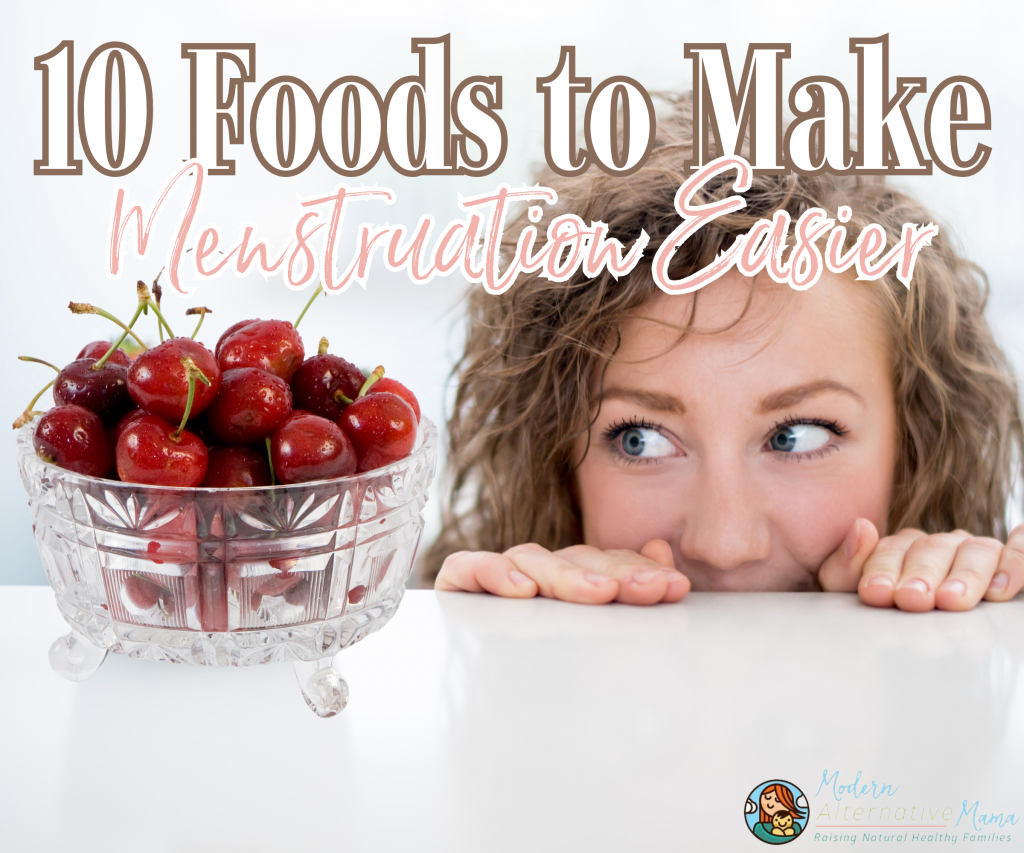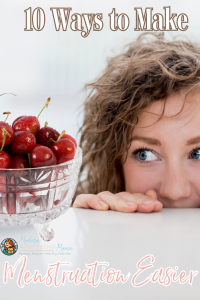So it’s that dreadful time of the month again, and you’re looking for relief. Maybe you tried over-the-counter medications that didn’t work, or you know the risks associated with acetaminophen, and you would rather skip that route. Or maybe you had absolutely unbearable monthlies, your daughter is close to that age, and you’d hate for her to struggle as you did. No matter why you’re here, the good news is you got here, and there are natural solutions that can help.
Why Menstruation is Difficult
Usually, when people are looking for menstrual cycle relief, it means they are struggling with cramping and other PMS symptoms. What we often overlook is why we have these symptoms.
First and foremost, I feel obligated to talk about feminine care products. If you read our article Everything You Need to Know About Feminine Care Products, you know that the ingredients found in mainstream feminine care products can cause hormone disruption and lead to increased menstrual cramping (1).
Feminine care products aside, let’s discuss PMS symptoms.
For many women, headaches, bloating, cramps, mood swings, pain, and food cravings will occur during or before their menstrual cycle. For other women, moderate to severe physical and emotional changes are experienced, known as premenstrual syndrome (PMS). PMS is also associated with mood swings, tender breasts, food cravings, fatigue, irritability, and depression (2). Studies show that upwards of 90 percent of women report experiencing disturbing PMS symptoms (3).
Although the cause of PMS is unclear, it seems to be related to hormone and brain chemical fluctuations (4). Right before the menstruation phase of a woman’s cycle, she is in the luteal phase. During the luteal phase, hormone levels start high as the body prepares the uterus for potential pregnancy from the ovulatory phase by thickening your uterine lining. If the egg isn’t fertilized, hormone levels decrease as the body prepares for the menstruation phase resulting in decreased estrogen and progesterone levels (5).
For some women, they will experience estrogen dominance and progesterone deficiency, which can affect a woman’s body in many ways, including:
- Abnormal menstruation (heavy/painful periods)
- PMS
- Headaches
- Decreased sex drive
- Bloating
- Mood swings
- Fatigue
- Anxiety and depression
- Breast tenderness
- Endometriosis
- Fibroids
- Hormonal weight gain (6)
Sound familiar? The good news is that you may just need liver support for PMS, but I still recommend reading on to see how to support this phase of your cycle naturally.
10 Foods to Make Menstruation Easier
As discussed in our article, How to Eat for Your Menstrual Cycle, the menstruation phase of a woman’s cycle begins the follicular phase. This phase begins a women’s cycle and typically lasts 1 to 5 days. During this phase, the lining of the uterus, the endometrium, is thick with fluids and nutrients designed to nourish an embryo. If an egg hasn’t been fertilized, it sheds, causing bleeding, often called a period. Estrogen and progesterone are low at this point of a woman’s cycle (7).
During the menstruation phase, it’s best to avoid or limit fatty foods, alcohol, caffeine, and salty foods, as these will increase inflammation in the body, which causes menstrual cramps and PMS (8). But enough about what to avoid, let’s discuss the foods that will make this time of the month easier.
Our body needs nutrients, especially when it’s that time of the month. Without vital vitamins and minerals, our bodies won’t function properly. Incorporating anti-inflammatory foods and herbs that boost estrogen is crucial and discussed in depth in our article Everything You Need to Know About Phytoestrogens. However, for now, let’s do a basic rundown.
Cherries
Aside from being highly nutritious and packed with fiber, vitamins, and minerals, cherries also have anti-inflammatory and sleep-promoting properties (9). Cherries are high in polyphenols, plant chemicals that help fight cellular damage, reduce inflammation, and promote overall health (10,11).
Anti-inflammatory properties are important because, during menstruation, the cells that form the uterus lining begin to break down and release large amounts of inflammatory prostaglandins. Prostaglandins constrict the uterine blood vessels, making the muscle layer contract, resulting in the painful cramps associated with menstruation (12). A literature review found that cherries reduced inflammation in 11 of 16 studies (13).
Additionally, cherries may help improve your sleep quality. As discussed in our blog, Everything You Need to Know About Melatonin, tart cherries are a natural source of melatonin. One study found seven consecutive days of drinking tart cherry juice significantly increased melatonin levels, sleep duration, and sleep quality compared to the placebo group (14). Another study found that drinking one cup of tart cherry juice before, for two weeks increased sleep time in older adults by 84 minutes (15).
Cramp Bark
Menstrual pain, sometimes called dysmenorrhea, affects up to 95 percent of women (16). If you read our cramp bark herbal profile, you know its name comes from its traditional use as a pain treatment for menstrual cramps, but its real name is guelder rose. One study found cramp bark supplementation, among other ingredients, reduces symptoms of PMS (17). Studies illustrate that cramp bark helps relieve pain and even supports female hormones (18).
Like cherries, cramp bark has anti-inflammatory properties. Several studies have found cramp bark decreases inflammation and intracellular oxidative stress while inducing DNA repair, without affecting the growth inhibition of lactic acid-beneficial microorganisms (19,20).
Dark Chocolate
Suppose you read our article discussing the health benefits of chocolate. In that case, you already know dark chocolate is rich in polyphenols, providing health benefits like reduced inflammation, better blood flow, lower blood pressure, and improved cholesterol and blood sugar levels (21). Dark chocolate is also rich in magnesium and other nutrients, which likely plays a role in its ability to reduce menstruation cramps (22,23,24,25). Additionally, studies have shown dark chocolate may improve mood and symptoms of depression (26).
Ginger
If you read our ginger herbal profile, you know an older study analyzed and split 150 women into three groups receiving four doses of either 250 milligrams of ginger powder, 250 milligrams of mefenamic acid, or 400 milligrams of ibuprofen per day. The study concluded that ginger just as effectively reduced menstrual pain as the two NSAIDs (27). Several recent studies found ginger as equally effective as medications like mefenamic acid and Novafen (28,29).
Lemon Balm
Suppose you read our lemon balm herbal profile. In that case, research has suggested that lemon balm is also suitable for pain control related to several grievances, including menstrual cramps, headaches, and physical injuries. In one study, researchers found that lemon balm reduced the severity of menstrual cramps in school-aged girls who took lemon balm for three consecutive cycles. Study researchers also found PMS symptoms to decrease significantly (30).
Additionally, lemon balm could benefit those struggling with hormonal headaches/menstrual migraines. Researchers concluded lemon balm’s relaxing properties resulted in the unwinding and relaxation of muscles. This released the tension that caused tight blood vessels, resulting in headaches (31).
Nettle
If you read our nettle herbal profile, you know nettle possesses an array of compounds that may reduce inflammation. In one animal study, results suggest that a portion of the anti-inflammatory effect of Urtica extract may be attributed to its inhibitory effect on NF-kappaB activation (part of the immune system responsible for inflammation development) (32). Nettle also reduced levels of numerous inflammatory hormones by interfering with their production in vitro (33).
Peppermint
If you read our peppermint herbal profile, you know peppermint is best known for relieving tension headaches and migraines due to its ability to act as a muscle relaxant and pain reliever. Peppermint also provides a cooling sensation (34). Peppermint’s ability to relieve certain headaches is likely due to the menthol in peppermint oil. Menthol increases the blood’s flow and provides a cooling sensation that assists in easing pain (35). In one clinical study of 35 people with migraines, when participants applied peppermint oil to the forehead and temples, the pain was reduced significantly after two hours compared to a placebo oil (36). In another study of 41 people, when participants applied peppermint oil topically to the forehead, they found it to be as effective for headaches as 1,000 mg of acetaminophen (37).
Peppermint may relieve menstrual cramps due to its ability to act as a muscle relaxant. One study found that 127 girls with painful periods who used peppermint extract capsules were as effective as a non-steroidal anti-inflammatory drug (38).
Peppermint’s ability to relax muscles may help you relax before bed (39). In one study, peppermint oil prolonged the sleeping time of mice (40). Peppermint may also enhance energy levels and diminish daytime fatigue, improving your ability to sleep at night. One study witnessed people experience less fatigue during a cognitive test when given peppermint oil capsules (41).
Red Raspberry Leaf
If you read our red raspberry leaf herbal profile, you know red raspberry leaves can help with the uncomfortable symptoms of menstrual cramps. Red raspberry leaf contains a plant compound called fragarine. Fragarine helps tone and tighten muscles in the pelvic area, which may reduce menstrual cramping while alleviating nausea and diarrhea associated with PMS (42). Finally, red raspberry leaves are rich in nutrients like iron, so they can help combat anemia in women with heavy menstrual cycles (43).
Spinach
Thanks to its nutrient-rich profile, spinach has long been recognized as a superfood. Spinach is rich in calcium, magnesium, potassium, folate, vitamin A, and more (44). Studies suggest a relationship between menstrual cramps and calcium and vitamin D levels (45). Another study found that thykamine extracts from spinach reduce acute inflammation (46).
Turmeric
If you read our turmeric herbal profile, you know it’s a relative of ginger with similar health properties. Turmeric has compounds called curcuminoids; curcumin is turmeric’s main ingredient and has a powerful anti-inflammatory effect (47). Studies have shown that curcumin matches the effectiveness of some anti-inflammatory drugs without the dangerous side effects (48).
Looking for a simpler way to manage menstrual discomfort? Earthley’s Ease the Ache uses the natural power of herbs to help relieve unbalanced hormones, pain, bloating, heavy bleeding, and more. They combined cramp bark, red raspberry leaf, motherwort, and nettle to create the best natural remedy for periods and postpartum afterpains.



